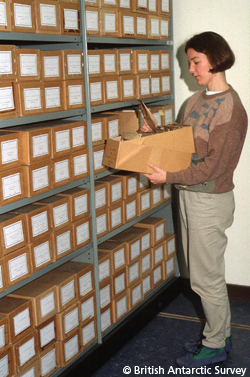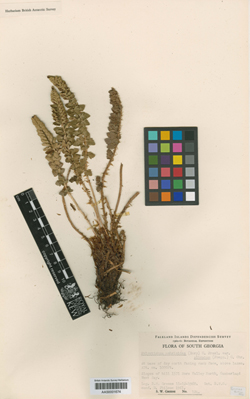

The British Antarctic Survey (BAS) Herbarium (herbarium code AAS) houses the largest single collection of plant, lichen and fungal specimens from Antarctic and sub-Antarctic regions in the world. It currently holds around 50000 specimens, the majority of which are mosses and lichens. This reflects the nature of the flora in these regions.

The BAS herbarium came into being in 1969 to hold the botanical collections made by the Falkland Islands Dependencies Survey (which was renamed the British Antarctic Survey in 1962) during the International Geophysical Year 1956-58 and numerous collections made in the 1960s. Initially it was housed at the University of Birmingham under the curatorship of Dr Stanley Greene. In 1975 the bryophyte collections were moved to the Institute of Terrestrial Ecology Bush Research Station in Edinburgh, as part of a new Bryophyte Project Group, whilst the remaining specimens, predominantly lichens, were housed at the British Antarctic Survey's new site in Cambridge. Finally in 1989, following the closure of the Bryophyte Project Group the collections were reunited at the British Antarctic Survey.
Collections have been added since the Herbarium's formation and it now houses around 50000 specimens - approximately 24500 mosses, 6000 liverworts, 17500 lichens, 2000 flowering plants, 200 ferns and 300 fungi. With the establishment of a punch paper-tape database in 1970, the specimen records have been held in a computerised form since the very early days of the Herbarium. They are now held in an Oracle database and, along with specimen records of Antarctic specimens held in many other world herbaria, form the Antarctic Plant Database.
The specimens have been used for a variety of taxonomic and scientific research projects and formed the basis for a variety of floras including:
* Greene S. W. (1964). The vascular flora of South Georgia. Scientific Report British Antarctic Survey No. 45.
* Øvstedal, D.O. & Lewis Smith, R.I. (2001). Lichens of Antarctica and South Georgia. A Guide to their Identification and Ecology. Cambridge University Press, Cambridge.
* Ochyra, R., Lewis Smith, R.I. & Bednarek-Ochyra, H. (2008). The illustrated moss flora of Antarctica. Cambridge University Press, Cambridge.
* Bednarek-Ochyra, H., Vána, J., Ochyra, R. & Lewis Smith, R.I. (2000). The liverwort flora of Antarctica. Polish Academy of Sciences, Institute of Botany, Cracow.


In 2009 the British Antarctic Survey and South Georgia Heritage Trust provided funds for the digitisation of all of the BAS herbarium vascular plant specimens by Kew. The images and specimen data are all available via this page and some, such as the South Georgia specimens, form part of the UKOTs Online Herbarium. Approximately 2000 specimens have been digitised comprising:
Herbarium specimens from South Georgia were digitized to form part of the UKOTs Online Herbarium, a project funded by the former Overseas Territories Environment Programme (OTEP), with additional support from the South Georgia Heritage Trust (SGHT). The British Antarctic Survey (BAS) herbarium specimens were also digitised to form part of the UKOTs Online Herbarium, with support from SGHT and BAS.
Please use the links below to see details on conservation activities in South Atlantic UK Overseas Territories



